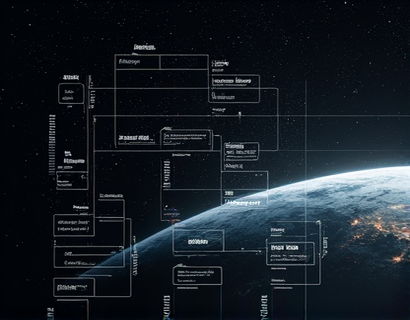Unlocking the Economic Power of Modern Ecosystems: Strategic Insights for Market Success
In the rapidly evolving landscape of global economics, the concept of ecosystems has emerged as a pivotal framework for understanding and harnessing the complex interdependencies that drive market dynamics. Modern ecosystems, characterized by their multifaceted networks of organizations, technologies, and processes, offer unprecedented opportunities for economic growth and innovation. This guide delves into the strategic insights necessary for professionals to identify and capitalize on emerging market opportunities within these ecosystems, providing essential knowledge for economists, business leaders, investors, and industry experts aiming to stay competitive and informed.
Understanding Modern Ecosystems
Modern ecosystems are not merely collections of entities but intricate webs of relationships where each participant plays a crucial role. These ecosystems are dynamic, adaptive, and often self-organizing, driven by the interactions and collaborations among their members. Unlike traditional economic models that focus on individual entities, ecosystems emphasize the collective value created through synergies and mutual benefits. This shift in perspective is crucial for understanding how to navigate and leverage these environments for economic success.
The key components of modern ecosystems include firms, suppliers, customers, technology platforms, and regulatory bodies, all interconnected through various relationships such as partnerships, supply chains, and value networks. Each element contributes to the overall resilience and innovation capacity of the ecosystem. For instance, technology platforms like Google and Amazon have created vast ecosystems that integrate hardware, software, and services, fostering a rich environment for startups and established companies alike to innovate and grow.
Economic Dynamics of Ecosystems
The economic dynamics within modern ecosystems are characterized by several distinct features. First, the network effect plays a significant role, where the value of a service or product increases as more people use it. This phenomenon is evident in social media platforms and marketplaces, where user base expansion leads to greater utility and attractiveness. Second, the concept of spillover effects is crucial, where the innovations and advancements in one part of the ecosystem benefit others, often leading to accelerated growth and development.
Another important aspect is the role of innovation, which is often catalyzed by the collaborative nature of ecosystems. Open innovation models, where companies share knowledge and resources, have become increasingly prevalent. This collaborative approach not only speeds up the innovation process but also reduces costs and risks. For example, the automotive industry's shift towards electric vehicles has been significantly driven by collaborations between car manufacturers, technology firms, and energy companies.
Strategic Insights for Navigating Ecosystems
To successfully navigate and capitalize on the opportunities within modern ecosystems, several strategic insights are essential. First, a deep understanding of the ecosystem's structure and dynamics is crucial. This involves mapping the key players, their roles, and the relationships between them. Tools such as network analysis and systems thinking can aid in visualizing and comprehending these complex interactions.
Second, fostering a culture of collaboration and open innovation is vital. Companies should actively seek partnerships and collaborations that can enhance their capabilities and expand their market reach. This might involve joining industry consortia, participating in research collaborations, or engaging in co-creation initiatives. By building a robust network of allies, businesses can tap into a broader pool of resources and expertise.
Third, adaptability and agility are key in the fast-paced environment of modern ecosystems. The ability to quickly respond to changes, whether they are technological advancements, regulatory shifts, or market trends, is crucial for sustained success. This requires a flexible organizational structure and a mindset that embraces continuous learning and improvement. Companies should invest in agile methodologies and foster a culture of experimentation and iteration.
Identifying Emerging Market Opportunities
Identifying emerging market opportunities within ecosystems involves a proactive and forward-looking approach. One effective strategy is to monitor technological trends and disruptions, as these often signal new areas of growth. For instance, the rise of artificial intelligence and blockchain technology has opened up numerous opportunities across various sectors, from healthcare to finance.
Another approach is to focus on underserved markets or segments where there is untapped potential. By conducting thorough market research and analyzing consumer needs, businesses can identify gaps that can be filled through innovative solutions. For example, the growing awareness of environmental issues has created a significant opportunity for companies offering sustainable products and services.
Additionally, leveraging data and analytics is crucial for spotting emerging trends and opportunities. Advanced data analytics can provide insights into consumer behavior, market dynamics, and competitive landscapes, enabling businesses to make informed decisions. By investing in data infrastructure and analytics capabilities, companies can gain a competitive edge and identify new market opportunities before they become widely recognized.
Building a Winning Ecosystem Strategy
Developing a winning ecosystem strategy requires a holistic approach that integrates various elements. First, companies should define clear goals and objectives aligned with the ecosystem's dynamics. This involves setting specific, measurable, achievable, relevant, and time-bound (SMART) goals that contribute to the overall ecosystem's growth and innovation.
Second, building strong relationships with key ecosystem players is essential. This includes fostering partnerships with suppliers, customers, and technology providers to create a supportive and collaborative environment. Effective communication and trust-building are critical in maintaining these relationships and ensuring mutual benefits.
Third, investing in research and development (R&D) is vital for staying ahead in the ecosystem. By continuously innovating and developing new products and services, companies can maintain their competitive position and contribute to the ecosystem's overall advancement. Collaborative R&D initiatives can further enhance this process by pooling resources and expertise.
Fourth, embracing a customer-centric approach is crucial for success in ecosystems. Understanding and meeting customer needs and preferences is key to driving adoption and loyalty. This involves not only listening to customer feedback but also proactively engaging with them to co-create value. By placing customers at the center of the ecosystem, businesses can ensure their offerings remain relevant and valuable.
Case Studies: Successful Ecosystem Strategies
Several companies have successfully harnessed the power of modern ecosystems to achieve market leadership. One notable example is Apple, which has built a robust ecosystem around its hardware, software, and services. By tightly integrating these components and creating a seamless user experience, Apple has fostered strong customer loyalty and a significant market share. The company's strategy of continuous innovation and collaboration with developers and partners has been instrumental in its success.
Another example is IBM, which has transformed itself by embracing open innovation and forming strategic partnerships across various industries. IBM's focus on cloud computing, artificial intelligence, and blockchain has enabled it to position itself as a leader in these emerging areas. By collaborating with startups, research institutions, and other tech giants, IBM has expanded its capabilities and market reach.
These case studies highlight the importance of a comprehensive ecosystem strategy that combines innovation, collaboration, and customer focus. By learning from these examples, businesses can develop their own strategies to thrive in the dynamic landscape of modern ecosystems.
Challenges and Mitigation Strategies
While the opportunities within modern ecosystems are vast, there are also significant challenges that businesses must navigate. One major challenge is the complexity and uncertainty inherent in ecosystem dynamics. The interconnected nature of relationships and the rapid pace of change can make it difficult to predict outcomes and manage risks. To mitigate this, companies should invest in robust risk management frameworks and maintain a flexible strategic approach.
Another challenge is the potential for increased competition as more players enter the ecosystem. To stand out, businesses must focus on differentiation through unique value propositions, innovation, and exceptional customer experiences. Building a strong brand and fostering a loyal customer base are essential in a crowded ecosystem.
Regulatory and compliance issues can also pose challenges, especially in highly regulated industries. Staying informed about regulatory changes and ensuring compliance is crucial for avoiding legal issues and maintaining trust. Engaging with regulatory bodies and participating in industry standards-setting can help businesses navigate these challenges more effectively.
Conclusion
Unlocking the economic power of modern ecosystems requires a deep understanding of their dynamics, strategic collaboration, and a forward-looking approach. By embracing the interconnected nature of these environments and leveraging the synergies they offer, businesses can identify and capitalize on emerging market opportunities. The insights provided in this guide aim to equip professionals with the knowledge and strategies needed to navigate and succeed in the dynamic economic landscape of today.










































